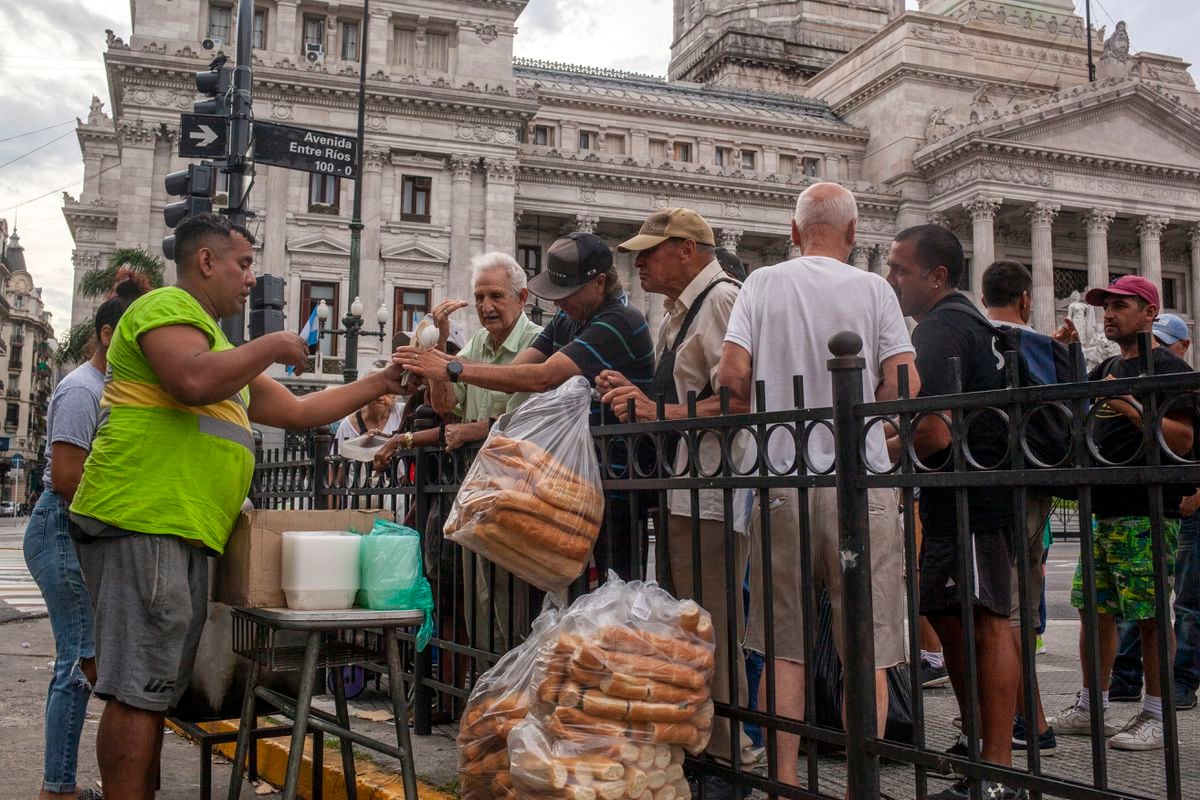The Aragonese bookseller Francisco J. Goyanes is an enthusiast of Latin American literature.
These days he has been animated by the Guadalajara International Book Fair, in Mexico, always on the lookout for news produced by the publishing industry on this side of the Atlantic.
Goyanes, who has been in the business for almost 40 years and is the founder of the Cálamo bookstore in Zaragoza, does not hide his excitement about one of those finds: a small book by the Colombian writer Laura Ortiz Gómez,
Sofoco
, which he carries like a treasure.
“What if they are read?”, She asks about the presence of Latin American writers in Spain.
"I think many of them do, nobody publishes books to throw money away," he comments jokingly.
Goyanes illustrates the relationship of Latin American literature with the Spanish market in this way: "If you ask a Spanish bookseller to tell you Latin American authors, he will name a few for you," he says.
He himself mentions several: Guadalupe Nettel, Margarita García Robayo, Horacio Castellanos Moya, Sergio Ramírez, Juan Villoro… “If you ask this same question to a Mexican, Argentine or Colombian bookseller, they will have much more difficulties beyond the hyper-consecrated ones.
He will tell you Javier Cercas, Rosa Montero and it's over, ”he adds.
The bookseller insists on his argument with the following example: Cálamo, his bookstore, has been awarding a literary prize since 2001 whose winners are chosen with the vote of the readers.
In this year's edition, of the 16 books chosen, there are five Spanish authors, two Peruvian,
A young woman reads the book Deception Island, by the author Paulina Flores Roberto Antillón
Publishers, booksellers and authors consulted by EL PAÍS agree on one premise: a new generation of Latin American writers are restoring the bridges between America and Spain.
“Before there were five authors, those of the
boom
, who sold thousands of copies.
Now there are dozens that sell less, but they are present in Spanish bookstores," says Aldo Perán, editor of Penguin Random House in Chile, at the FIL in Guadalajara, the most important in Spanish, which has brought together thousands of professionals until this Sunday. of the sector.
Perán highlights, apart from his own (which in terms of number of titles is unbeatable), the work of small labels in Madrid and Barcelona such as Tránsito or Las afueras.
The former has in its catalog authors such as Cristina Rivera Garza, Fernanda Trías or Jazmina Barrera.
The second is rescuing all the work of the Chilean Pedro Lemebel and publishes, among others, Circe Maia and Daniela Catrileo.
In many cases, independent labels —who do not need large sales to make a title profitable— bet on demanding but uncommercial authors.
This explains why the Chilean Diamela Eltit, winner of the FIL Romance Languages Award in 2020, publishes with Seix Barral in her country and with Periférica from Cáceres in Spain.
Or the bet of the Barcelonan Rayo Verde by Juan José Saer, author of Planeta in Argentina.
Penguin Random House launched the Map of Languages program in Spain in 2015 to try to find readers interested in Latin American literature wherever they were instead of throwing them into the maelstrom of the Spanish market, marked by a continuous flow of ephemeral novelties.
With print runs of 500 copies distributed in 150 “literary” bookstores, today iconic titles circulated thanks to the Map of Languages, such as
Hurricane Season
, by the Mexican Fernanda Melchor;
La perra
, by the Colombian Pilar Quintana, or
The unknown dimension
, by the Chilean Nona Fernández.
In 2020, the multinational expanded the program to all of America and included Spanish authors such as Manuel Jabois or Ana Iris Simón.
Published in Spain by the independent label Círculo de Tiza, Simón's book,
Feria
, circulates in America in the Alfaguara catalogue.
This ensures a transatlantic diffusion that his Spanish publisher cannot guarantee.
The most emblematic case would, however, be
El infinito en un junco
, by Irene Vallejo, published by Siruela in 2019 and turned three years later —by means of a pandemic— into one of the great successes of FIL.
Although the regular edition of Siruela can be obtained in some bookstores, its large circulation is due to the cheaper version, the result of an agreement between that label and Debolsillo (Penguin Random House).
One costs 606 pesos (30 euros);
the other, 399 (20 euros).
The minimum daily wage has just risen in Mexico from 172 pesos to 207.
A woman reads the book by Irene Vallejo 'The infinite in a reed' at FIL, on November 27.Roberto Antillon
In addition to the price difference, Alejandro Barahona, director of the distributor Panoplia, points to the size of each publisher.
“When a Spanish title begins to succeed in America, its author's agents demand a presence in all bookstores.
That can only be guaranteed by a multinational.
That is why the little ones have to resign themselves to reaching agreements or releasing the rights for Mexico, Colombia or Argentina”.
In Latin America, the books that Irene Vallejo has published with Contraseña, her small publishing house from Zaragoza, are published by Penguin.
Hence the continuous visits to America by independent Spanish publishers interested in that pan-Hispanic market.
Publishers and booksellers mention the case of Páginas de espuma, which works in many countries almost like a local label thanks to the work of its director, Juan Casamayor.
Something similar happens the other way around, explains Barahona: “It is true that Latin American literature is more interesting now in Spain, but the landing in Europe of stamps on this side of the pond is sometimes due, beyond what they are going to sell, to an attempt to negotiate the rights for the entire language”, says Barahona.
This dynamic partly explains the landing in Madrid of labels such as the Mexicans Sexto Piso and Almadía or the Argentines Adriana Hidalgo, Eterna cadencia, Blatt & Ríos or Mardulce.
Guillermo Quijas, founder of Almadía, expresses it briefly: “To the extent that a book has a greater reach and exists in a market as strong as the Spanish one, it has more possibilities of reaching a greater reach in Latin America.
Of course it does not happen with all books.
Quijas mentions the example of
Furia
, by Clyo Mendoza, a 2021 book that has sold around 7,000 copies in Mexico, according to data from the publisher, and 4,000 in Spain, where it was co-published with Sigilio: "Yes, it has had an impact that is publish in Spain.
This has catapulted translations, for example: in Brazil, it has just come out;
an Italian label bought the translation, one is about to come out in French, an American production company is going to make a film...”.
Much of the growing interest in Latin American literature in Spain is due, precisely, to the attention aroused by female writers, whose visibility, moreover, has put part of the focus on major names overshadowed by the boom of the sixties (from Elena Garro to Sara Gallardo through María Luisa Bombal) or scorned for decades for their use of popular references: there is the recovery of Manuel Puig by Seix Barral (with prologues by Claudia Piñeiro, Camila Sosa Villada or Paulina Flores).
Young authors like Mariana Enriquez or Liliana Colanzi have also broken the canonical taboo that hung over horror or science fiction literature.
Fantasy is no longer just a matter of magical realism.
“There is a great moment for literature written by women.
There is a discovery and there is also a great writing”,
Young readers look for Mariana Enriquez books at the Guadalajara International Book Fair on November 27, 2022. Hector Guerrero
Andrés Ossa, director of the Regional Center for the Promotion of Books in Latin America and the Caribbean (Cerlalc), points out, however, that the presence of Latin American authors in Spain is "much less than what the fact of sharing a language makes possible." .
Ossa points out that the Spanish book sector has Latin America as the main destination of its exports, but the same is not true in the opposite direction.
He offers data from the latest available report from the Federation of Publishers Guilds of Spain: “In 2020, 47% of the sector's exports were destined for Latin America.
In contrast, imports from America represent only 11.5%”.
However, in 2015, this last figure did not exceed 1.2% (by 36% in the reverse direction).
According to this study, Spain exported 75.4 million euros worth of books to Mexico, 35 to Argentina,
6 million, and Colombia 10.1 million.
On the other hand, imports of books from America, including the United States and Canada, were 12.1 million euros.
The difficult journey of the book within Latin America
Spain continues to be, 10,000 kilometers away, the main center of massive and global dissemination of Latin American literature.
Hand in hand, above all, with the two large groups: Planeta and Penguin Random House, which share around 40% of the market.
"In Guatemala we began to read Horacio Castellanos Moya when Tusquets (Planeta) published it in Barcelona."
The phrase is from Philippe Hunziker, editor and owner of Sophos, one of the large bookstores in the region, based in Guatemala City.
If the flow between America and Spain were to consolidate, the circulation of books within America itself would still be pending, as Hunziker points out.
Typically, a novel published by Alfaguara in Bogotá does not leave Colombia for a neighboring country if the same label does not program it in Madrid.
Alejandro Barahona underlines the difficulty of circulation from north to south, even between neighbors, with a common case in his work: “Sometimes a Chilean bookseller doesn't get a Peruvian book.
He asks me as an importer.
I get it in Spain, where he has arrived imported from Peru.
When I sell it to the bookseller in Chile, it can be worth up to double what it originally cost."
All in all, the phenomenon of independent publishers, common to the entire field of Spanish, sometimes succeeds in solving a problem that multinationals cannot solve due to lack of waistlines or because the accounts do not add up.
In 2007, the selection of new Latin American authors
Bogotá 39
arrived in bookstores with the logo of
Ediciones B, then part of Grupo Zeta and today, of Penguin Random House.
Circulation of the anthology was scarce outside of Colombia and 10 years later the Hay Festival, promoter of the anthology, resorted to 12 different labels: from Tragaluz (Colombia) to Estruendomudo (Peru) passing through Galaxia Gutenberg (Mexico/Spain), Uruk (Costa Rica), Laurel (Chile) or Stealth (Argentina).
Industry professionals strive to ensure that books travel across the continent.
Paula Canal, agent and founder of the Indent Literary Agency, represents fifty Latin American authors in Mexico, such as Vanessa Londoño, author of
Animal Siege
, or Pedro Mairal, author of
La Uruguaya
.
Canal explains that when she negotiates the contracts of her writers, she makes sure that the authors can recover the rights to their works if the books have not been distributed in certain territories after a certain time.
She happened, for example, so that
Mugre rosa
(Random House), by Fernanda Trías, would arrive in Bolivia, where it is published by the Mantis publishing house.
It almost happens also with
The Year of the Wind
by the Peruvian Karina Pacheco, which after 14 months has not yet been published outside of Peru.
“Planeta, which has the worldwide rights, did not publish it in any other territory.
Last week they gave it the National Literature Prize and now they are going to take it out in all the countries,” says Canal, adding: “It didn't happen before.
They just never came and that's it”.
subscribe here
to the EL PAÍS México
newsletter
and receive all the key information on current affairs in this country




/cloudfront-eu-central-1.images.arcpublishing.com/prisa/IOQ5LVJEOFAEZHGFMYWVXLFURI.jpg)




